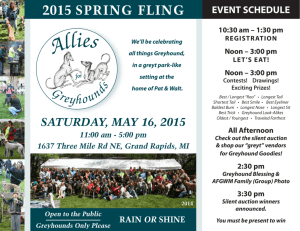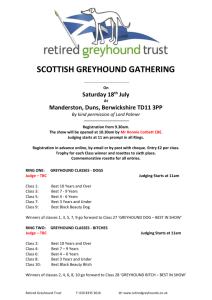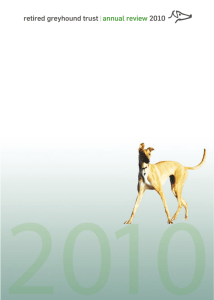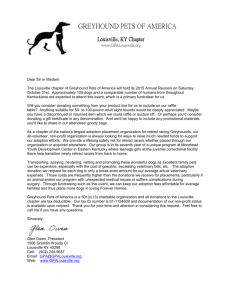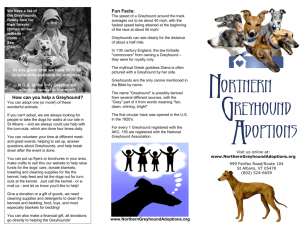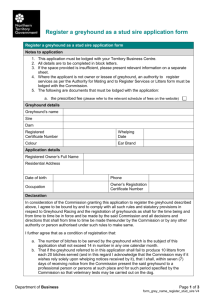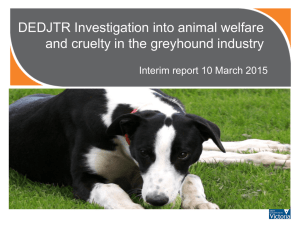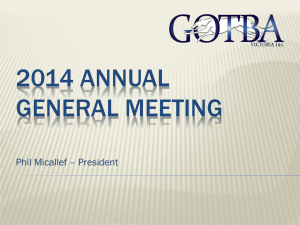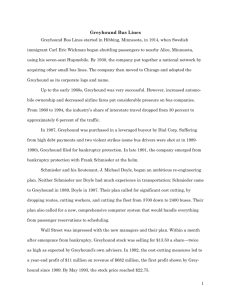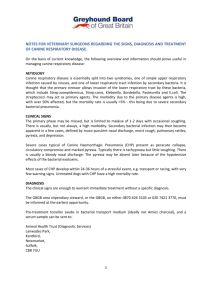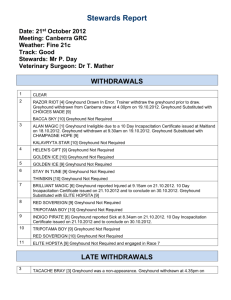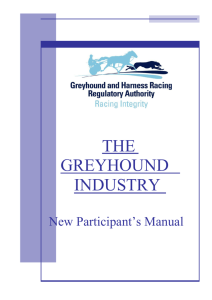25088 Manage a greyhound-breeding programme
advertisement
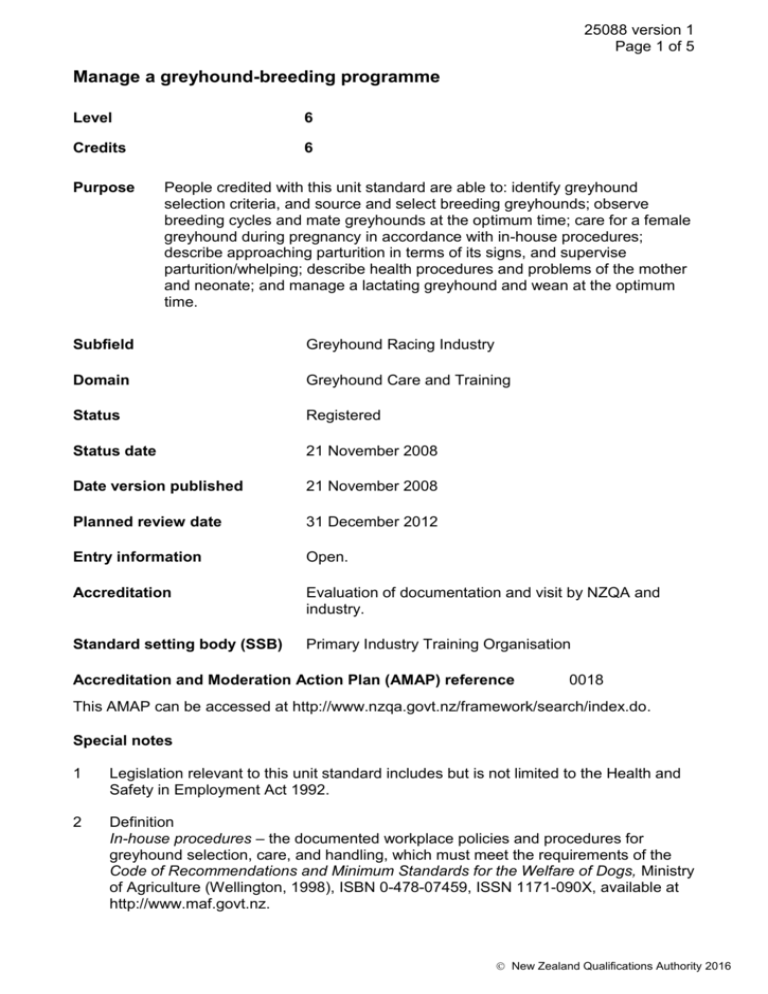
25088 version 1 Page 1 of 5 Manage a greyhound-breeding programme Level 6 Credits 6 Purpose People credited with this unit standard are able to: identify greyhound selection criteria, and source and select breeding greyhounds; observe breeding cycles and mate greyhounds at the optimum time; care for a female greyhound during pregnancy in accordance with in-house procedures; describe approaching parturition in terms of its signs, and supervise parturition/whelping; describe health procedures and problems of the mother and neonate; and manage a lactating greyhound and wean at the optimum time. Subfield Greyhound Racing Industry Domain Greyhound Care and Training Status Registered Status date 21 November 2008 Date version published 21 November 2008 Planned review date 31 December 2012 Entry information Open. Accreditation Evaluation of documentation and visit by NZQA and industry. Standard setting body (SSB) Primary Industry Training Organisation Accreditation and Moderation Action Plan (AMAP) reference 0018 This AMAP can be accessed at http://www.nzqa.govt.nz/framework/search/index.do. Special notes 1 Legislation relevant to this unit standard includes but is not limited to the Health and Safety in Employment Act 1992. 2 Definition In-house procedures – the documented workplace policies and procedures for greyhound selection, care, and handling, which must meet the requirements of the Code of Recommendations and Minimum Standards for the Welfare of Dogs, Ministry of Agriculture (Wellington, 1998), ISBN 0-478-07459, ISSN 1171-090X, available at http://www.maf.govt.nz. New Zealand Qualifications Authority 2016 25088 version 1 Page 2 of 5 3 For this unit standard the practical assessment evidence must be provided in the context of a commercial greyhound business operation under normal working conditions. 4 Documentation required for The Australian and New Zealand Greyhound Stud Book (referred to as the Greyhound Stud Book) is available from the Racing Registrar, NZ Greyhound Racing Association, PO Box 38899, Wellington Mail Centre 5045, New Zealand. Phone: 04-589-4900, or website http://nzgra.org.nz. 5 Reference Craig Taberner, Michelle Grima, Steven Hosking, Janet Kenney, Jacqueline Gomm, (compilers), The Australian and New Zealand Greyhound Stud Book, (Melbourne: McPherson’s Printing Group, 2007). Elements and performance criteria Element 1 Identify greyhound selection criteria, and source and select breeding greyhounds. Performance criteria 1.1 Greyhound selection criteria are identified in accordance with in-house procedures. Range 1.2 results of – progeny assessments, genetic analysis, pedigree, temperament, age, health status, suitability for purpose, movement, soundness. Breeding greyhounds are sourced and selected according to selection criteria and in-house procedures. Element 2 Observe breeding cycles and mate greyhounds at the optimum time. Performance criteria 2.1 The oestrous cycle of a female greyhound is identified according to individual patterns. Range 2.2 behaviour, appearance, blood sample, vaginal smear. Male and female greyhounds are introduced for mating at optimum time, in a manner which is suitable for greyhounds and does not cause stress for either animal. New Zealand Qualifications Authority 2016 25088 version 1 Page 3 of 5 2.3 Mating is supervised while allowing natural courtship procedures to precede actual mating. Range 2.4 according to experience of male and female, possible differences in height, environment. Assistance is provided when artificial mating is carried out, as instructed by the veterinarian. Element 3 Care for a female greyhound during pregnancy in accordance with in-house procedures. Performance criteria 3.1 Pregnancy is confirmed and approximate stage of gestation determined using mating dates. 3.2 Pregnant female is fed to maintain optimum body condition for birth/whelping according to stage of pregnancy. 3.3 Health care is provided to ensure female and offspring have opportunity for optimum health. Range vaccination, ectoparasite and endoparasite control, nutritional supplementation, exercise. 3.4 Any abnormalities of pregnancy are identified, and action is taken according to in-house procedures. 3.5 Area for parturition/whelping is prepared according to individual needs, and female is introduced to area in a manner which assists nesting instinct. Range size, bedding, location, company, security, heating, lighting. Element 4 Describe approaching parturition in terms of its signs, and supervise parturition/whelping. Performance criteria 4.1 A suitable environment for parturition is described according to individual greyhound and species requirements. 4.2 Problems of parturition are identified and described in terms of their signs, and the appropriate action is taken in accordance with in-house procedures. Range problems – behavioural, physiological, malpresentation, dystocia (foetal or maternal), uterine inertia, delay in delivery, abnormal behaviour, haemorrhage, unusual discharge, prolapse of uterus, straining without delivery; action – assist with parturition, summon veterinary assistance. New Zealand Qualifications Authority 2016 25088 version 1 Page 4 of 5 4.3 Parturition is supervised without unnecessary intervention. 4.4 Newborn pups are assessed to determine health status according to in-house procedures. Range physical, physiological. 4.6 Documentation for The Greyhound Stud Book is completed within required time period in accordance with New Zealand Greyhound Racing Association requirements. 4.7 Caesarean section pre and post-operative care is provided for mother and newborn to maximise probability of survival. Range environment, nutrition and water for mother, introduction of newborn to mother, care of mother’s wound. Element 5 Describe health procedures and problems of the mother and neonate. Performance criteria 5.1 Health procedures for the mother and neonate are described in terms of the maintenance of optimal health and survival following parturition. Range 5.2 Problems that may affect the mother post-parturition are described in terms of their signs and responses. Range 5.3 procedures include but are not limited to those relating to – umbilical cord, hygiene, respiration, circulation, congenital abnormalities, access to mammary area. retained foetal membranes, metritis, mastitis, eclampsia. Problems involving milk supply of mother and suckling behaviour of neonate are described in terms of their signs and responses. Range insufficient milk, failure to suckle, physical abnormalities of mother, mother’s fluid/nutritional supply, teat numbers. Element 6 Manage a lactating greyhound and wean at the optimum time. Performance criteria 6.1 Requirements of, and any problems with, lactation are identified, and action is taken in accordance with in-house procedures. Range bacterial, physical, behavioural, nutritional. New Zealand Qualifications Authority 2016 25088 version 1 Page 5 of 5 6.2 The lactating greyhound is provided with a diet to maintain adequate body condition for self and to provide sufficient milk for offspring. Range 6.3 frequency, amount, type, timing. Offspring are weaned at an age suitable for the greyhound, in a manner which is least stressful for mother and offspring, and meets natural socialisation needs of pups. Please note Providers must be accredited by NZQA, or an inter-institutional body with delegated authority for quality assurance, before they can report credits from assessment against unit standards or deliver courses of study leading to that assessment. Industry Training Organisations must be accredited by NZQA before they can register credits from assessment against unit standards. Accredited providers and Industry Training Organisations assessing against unit standards must engage with the moderation system that applies to those standards. Accreditation requirements and an outline of the moderation system that applies to this standard are outlined in the Accreditation and Moderation Action Plan (AMAP). The AMAP also includes useful information about special requirements for organisations wishing to develop education and training programmes, such as minimum qualifications for tutors and assessors, and special resource requirements. Comments on this unit standard Please contact the Primary Industry Training Organisation standards@primaryito.ac.nz if you wish to suggest changes to the content of this unit standard. New Zealand Qualifications Authority 2016
